Canada Lifts 25% Tariff on Select U.S. Goods to Ease Trade Tensions

Canada has announced it will lift the 25% tariff on a select group of U.S. imports starting September 1, marking a calculated shift in its trade strategy. The tariff relief applies to goods like orange juice, peanut butter, household appliances, and motorcycles—products previously targeted in retaliation for U.S. trade measures. The change affects approximately $21 billion in goods and follows a recent diplomatic exchange between Prime Minister Mark Carney and former U.S. President Donald Trump.
The 25% tariff, introduced as part of a broader retaliatory package, had drawn criticism from Canadian retailers and consumers due to rising prices and supply chain disruptions. With inflationary pressures still weighing on households, the government now appears focused on easing domestic cost burdens without entirely abandoning its leverage in trade negotiations.
Crucially, Canada is not lifting all tariffs. Duties on steel, aluminum, and autos remain intact—suggesting that Ottawa is preserving its ability to respond if the U.S. intensifies trade restrictions under the USMCA framework. Officials maintain the move aligns with North American trade norms, especially as the region prepares for the upcoming USMCA policy review.
Bank of Canada analysts and market observers note that the rollback may provide modest relief to inflation-sensitive sectors, giving the central bank more room to assess future interest rate decisions. While the move has drawn support from business groups and provincial governments, some critics argue that Canada may have weakened its negotiating position without securing reciprocal concessions from Washington.
The timing also raises questions about the effectiveness of political messaging. Carney’s announcement comes as U.S. economic talks dominate headlines ahead of the Jackson Hole Economic Symposium. If the tariff rollback leads to price stabilization, it could serve as a domestic win. But its effectiveness hinges on whether the U.S. government reciprocates or uses the moment to press for broader concessions.
Ultimately, lifting the 25% tariff on specific U.S. goods is both an economic and political calculation. It signals a willingness to de-escalate trade friction while keeping pressure where it counts—on strategic industries that underpin Canada’s long-term financial resilience.


















































